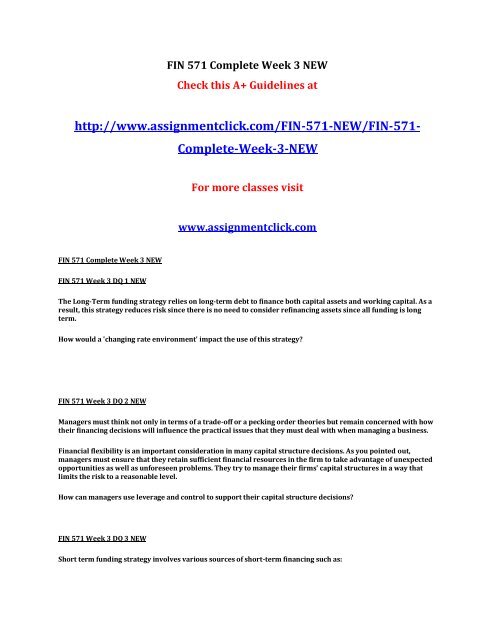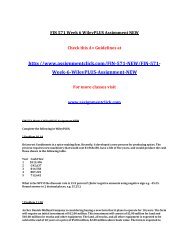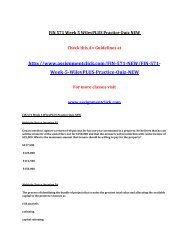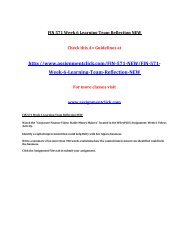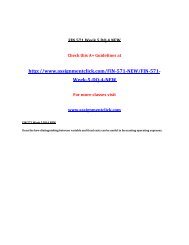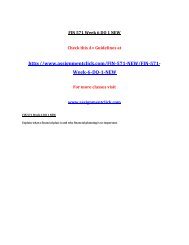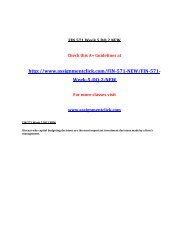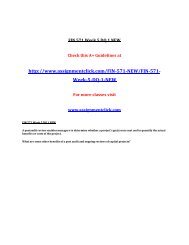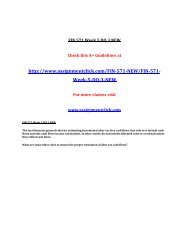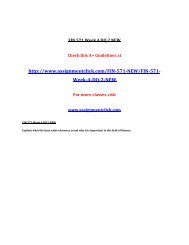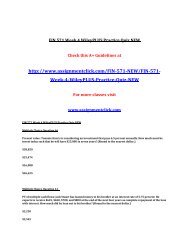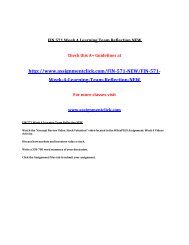UOP FIN 571 Complete Week 3 UOP
Create successful ePaper yourself
Turn your PDF publications into a flip-book with our unique Google optimized e-Paper software.
<strong>FIN</strong> <strong>571</strong> <strong>Complete</strong> <strong>Week</strong> 3 NEW<br />
Check this A+ Guidelines at<br />
http://www.assignmentclick.com/<strong>FIN</strong>-<strong>571</strong>-NEW/<strong>FIN</strong>-<strong>571</strong>-<br />
<strong>Complete</strong>-<strong>Week</strong>-3-NEW<br />
For more classes visit<br />
www.assignmentclick.com<br />
<strong>FIN</strong> <strong>571</strong> <strong>Complete</strong> <strong>Week</strong> 3 NEW<br />
<strong>FIN</strong> <strong>571</strong> <strong>Week</strong> 3 DQ 1 NEW<br />
The Long-Term funding strategy relies on long-term debt to finance both capital assets and working capital. As a<br />
result, this strategy reduces risk since there is no need to consider refinancing assets since all funding is long<br />
term.<br />
How would a 'changing rate environment' impact the use of this strategy?<br />
<strong>FIN</strong> <strong>571</strong> <strong>Week</strong> 3 DQ 2 NEW<br />
Managers must think not only in terms of a trade-off or a pecking order theories but remain concerned with how<br />
their financing decisions will influence the practical issues that they must deal with when managing a business.<br />
Financial flexibility is an important consideration in many capital structure decisions. As you pointed out,<br />
managers must ensure that they retain sufficient financial resources in the firm to take advantage of unexpected<br />
opportunities as well as unforeseen problems. They try to manage their firms' capital structures in a way that<br />
limits the risk to a reasonable level.<br />
How can managers use leverage and control to support their capital structure decisions?<br />
<strong>FIN</strong> <strong>571</strong> <strong>Week</strong> 3 DQ 3 NEW<br />
Short term funding strategy involves various sources of short-term financing such as:
Accounts payable (trade credit), bank loans, and commercial paper are common sources of short-term financing.<br />
Accounts payable constituted about 35 percent of total current liabilities for all publicly traded manufacturing<br />
firms. The buyer needs to figure out whether it makes financial sense to pay early and take advantage of the<br />
discount or to wait and pay in full when the account is due.<br />
Short-term bank loans accounted for about 20 percent of total current liabilities for all publicly traded<br />
manufacturing firms. An informal line of credit is a verbal agreement between the firm and the bank, allowing<br />
the firm to borrow up to an agreed-upon upper limit.<br />
In exchange for providing the line of credit, a bank may require that the firm holds acompensating balance with<br />
them.<br />
What are some other sources of short-term financing used with this strategy?<br />
<strong>FIN</strong> <strong>571</strong> <strong>Week</strong> 3 Individual Interpreting Financial Results NEW<br />
Resource: Financial Statements for the company assigned by your instructor in <strong>Week</strong> 2.<br />
Review the assigned company's financial statements from the past three years.<br />
Calculate the financial ratios for the assigned company's financial statements, and then interpret those results<br />
against company historical data as well as industry benchmarks:<br />
<br />
<br />
Compare the financial ratios with each of the preceding three (3) years (e.g. 2014 with 2013; 2013 with<br />
2012; and 2012 with 2011).<br />
Compare the calculated financial ratios against the industry benchmarks for the industry of your<br />
assigned company.<br />
Write a 500 to 750 word summary of your analysis.<br />
Show financial calculations where appropriate.<br />
Click the Assignment Files tab to submit your assignment.<br />
<strong>FIN</strong> <strong>571</strong> <strong>Week</strong> 3 Learning Team Reflection NEW<br />
Watch the "Concept Review Video: Working Capital Management" video located in theWileyPLUS Assignment:<br />
<strong>Week</strong> 3 Videos Activity.<br />
Discuss strategies these business owners used to manage their working capital.<br />
Write a 350-700 word summary of your discussion.<br />
Click the Assignment Files tab to submit your assignment.
<strong>FIN</strong> <strong>571</strong> <strong>Week</strong> 3 WileyPLUS Practice Quiz NEW<br />
Multiple Choice Question 32<br />
The operating cycle<br />
ends not with the finished goods being sold to customers and the cash collected on the sales; but when you take<br />
into account the time taken by the firm to pay for its purchases.<br />
To measure operating cycle we need another measure called the days' payables outstanding.<br />
begins when the firm receives the raw materials it purchased that would be used to produce the goods that the<br />
firm manufactures.<br />
begins when the firm uses its cash to purchase raw materials and ends when the firm collects cash payments on<br />
its credit sales.<br />
Multiple Choice Question 57<br />
You are provided the following working capital information for the Ridge Company:<br />
Ridge Company<br />
Account $<br />
Inventory $12,890<br />
Accounts receivable 12,800<br />
Accounts payable 12,670<br />
Net sales $124,589<br />
Cost of goods sold 99,630<br />
Operating cycle: What is the operating cycle for Ridge Company?<br />
51 days<br />
47 days<br />
85 days
36 days<br />
Multiple Choice Question 80<br />
Ticktock Clocks sells 10,000 alarm clocks each year. If the total cost of placing an order is $65 and it costs $85 per<br />
year to carry the alarm clock in inventory, use the EOQ formula to calculate the optimal order size.<br />
26,154 clocks<br />
24 clocks<br />
15,294 clocks<br />
161 clocks<br />
Multiple Choice Question 49<br />
The asset substitution problem occurs when<br />
managers substitute less risky assets for riskier ones to the detriment of equity holders.<br />
managers substitute riskier assets for less risky ones to the detriment of bondholders.<br />
managers substitute less risky assets for riskier ones to the detriment of bondholders.<br />
managers substitute riskier assets for less risky ones to the detriment of equity holders.<br />
Multiple Choice Question 53<br />
M&M Proposition 1: Dynamo Corp. produces annual cash flows of $150 and is expected to exist forever. The<br />
company is currently financed with 75 percent equity and 25 percent debt. Your analysis tells you that the<br />
appropriate discount rates are 10 percent for the cash flows, and 7 percent for the debt. You currently own 10<br />
percent of the stock.<br />
How much are your cash flows today?<br />
$4.50<br />
$12.38<br />
$150<br />
$15
Multiple Choice Question 62<br />
M&M Proposition 2: Melba's Toast has a capital structure with 30% debt and 70% equity. Its pretax cost of debt is<br />
6%, and its cost of equity is 10%. The firm's marginal corporate income tax rate is 35%. What is the appropriate<br />
WACC?<br />
6.35%<br />
7.44%<br />
8.80%<br />
8.17%<br />
Multiple Choice Question 39<br />
According to the text, the financial plan covers a period of<br />
ten years.<br />
none of these.<br />
one year.<br />
three to five years.<br />
Multiple Choice Question 45<br />
The financing plan of a firm will indicate<br />
the firm's dividend policy, the desired capital structure for the firm, and the firm's working capital policy.<br />
the dollar amount of funds that has to be raised externally and the sources of funds available to the firm, the<br />
desired capital structure for the firm, and the firm's dividend policy.<br />
the dollar amount of funds that has to be raised externally and the sources of funds available to the firm, the<br />
desired capital structure for the firm, and the firm's working capital policy.<br />
the dollar amount of funds that has to be raised externally and the sources of funds available to the firm, the<br />
firm's dividend policy, and the firm's working capital policy.<br />
Multiple Choice Question 74<br />
Payout and retention ratio: Tradewinds Corp. has revenues of $9,651,220, costs of $6,080,412, interest payment<br />
of $511,233, and a tax rate of 34 percent. It paid dividends of $1,384,125 to shareholders. Find the firm's<br />
dividend payout ratio and retention ratio.
25%, 75%<br />
66%, 34%<br />
34%, 66%<br />
69%, 31%


